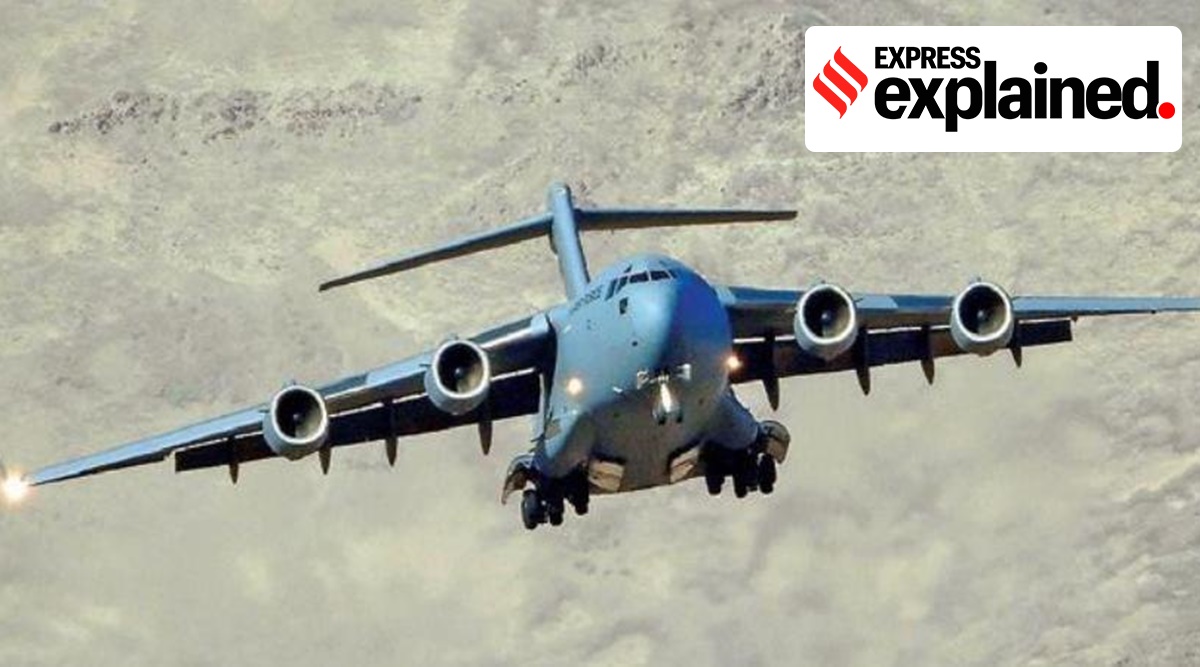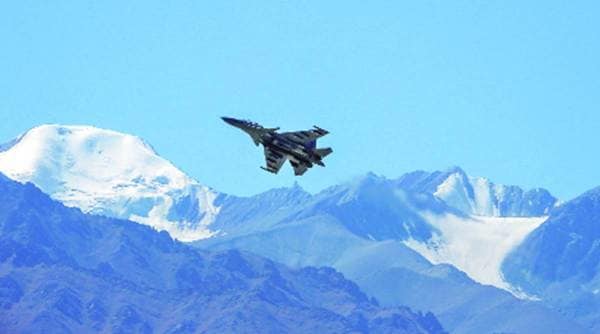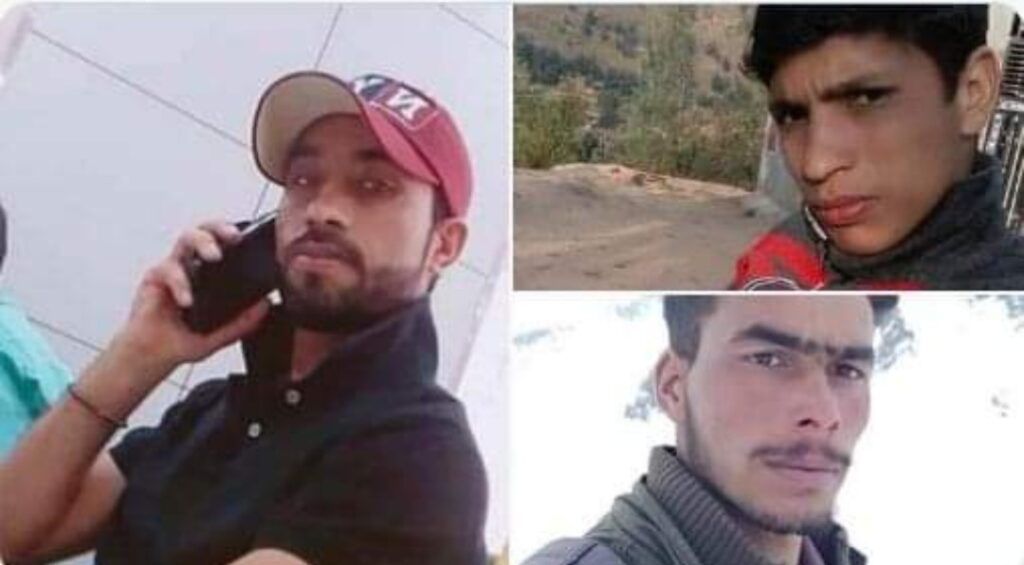The Indian Army is preparing for extended deployment at the LAC through the winter months. This leaves the IAF with a key role in providing support to the troops. What are the challenges to meet in the harsh winter and tough terrain?
Written By: Manmohan Bahadur | New Delhi
With a resolution to the standoff on the LAC still elusive, the Indian Army is preparing for extended deployment of troops in the region through the winter months. This leaves the IAF with a key role in providing support to the troops. What are the challenges to meet in the harsh winter and tough terrain?
 A C-17 Globemaster of the Indian Air Force flies over the Ladakh region. (PTI Photo)
A C-17 Globemaster of the Indian Air Force flies over the Ladakh region. (PTI Photo)
Can the IAF support the logistics of such a large force?
One part of the logistics for the Army requires land transportation, which would have been planned for before winter sets in and the passes close. The IAF will be doing very urgent missions, for which it is well prepared with a very good transport fleet consisting of C-17 Globemasters, Il-76s, and many An-32s. If it comes to the crunch, the C-130 Super Hercules can also be used for logistics support, although these are meant for special operations.
We also have Mi-17 helicopters and Cheetal light helicopters to cater to forward posts. In addition, the Chinook heavy-lift helicopters will be used for carrying bulky stores, either within the fuselage, or slung under it.
THE EXPERT
Air Vice Marshal (retired) Manmohan Bahadur is an IAF veteran and currently Additional Director General, Centre for Air Power Studies, New Delhi. Commissioned in the IAF in 1976, he commanded the 114 Helicopter Unit at Leh and Air Force flying bases in Jammu and Guwahati. He was the first pilot to land on the Siachen Glacier in September 1978, six years before Operation Meghdoot was launched. He has been Head of Training at Defence Services Staff College. He served as Assistant Chief of Air Staff in charge of transport and helicopter operations and moved to HQ Integrated Defence Staff before his retirement in May 2011.
What are the topographical challenges of flying into Leh or other advanced landing grounds (ALGs) in Eastern Ladakh?
The biggest challenge is the altitude of the two airfields of Leh and Thoise, but since we have been flying there for decades, the air crew are well aware of the peculiarities of these fields.
The landing grounds at high altitude have their own challenges, which result in reduction of load-bearing capacity of the planes/choppers. Additionally, the air crew have to call upon their skills to navigate the hills and land on the small, matchbox-like helipads — there is just no place on these hills to make bigger ones!
What additional hazards will winter bring?
Bad weather that accompanies the western disturbances that strike northern India in the winter months is a challenge, as it reduces visibility and results in a low cloud base. So the crew have to be on the ball to make sure they can find a way to circumvent bad weather. This is not always possible, and we have long periods when flying has to be curtailed.
And what effect does extreme cold have on weight-carrying aircraft?
The lower the temperature, the better the payload because the higher air density increases the lift-carrying capability of flying machines. So the loads that can be carried during winter are higher than during summer.
This is a big advantage. For instance, an Il-76, which in summer can carry hardly any load from Leh, can fly out around 20 tonnes in the winter. It is the same with helicopters, whose load-carrying ability to extremely high helipads at altitudes of 17,000 to 20,000 feet increases substantially in winter. And it reduces drastically in summer.
 An Indian Air Foce Su-30MKI jet flies over Ladakh. (PTI Photo)
An Indian Air Foce Su-30MKI jet flies over Ladakh. (PTI Photo)
Do the high altitude and topography pose a challenge to navigation and night flying?
The modern navigation equipment available now overcome most of the challenges. But mission accomplishment is not merely flying from place A to B. The aircraft has to land to complete a mission. That is where temperature and altitude plus weather become the final arbiters.
Navigation is not a problem, but take-offs and landings are tricky.
As for night flying, it has its own unique challenges because of the shadows cast by hills, as well as the state and position of the moon relative to the hills and the aircraft. A dark, moonless night poses its own challenges, and a full moon has its own. In the hills, air crew are specially cleared to carry out operations at night.
Do the airfields in Ladakh restrict operations to only certain aircraft or can all aircraft be used?
All air fields in the Ladakh area can be used by the transport aircraft we have, although weather requirements will vary from one aircraft to the other. It depends on the navigational aids on board the aircraft, and the competence of the crew. That is why air crews are detailed depending on the mission.
In a long haul, or in the eventuality of a kinetic war, the IAF will also have to transport back and forth mechanised weapons etc for repair, maintenance, etc. Can our aircraft profile cater to it?
Bringing back loads from the forward air fields is not a problem. However, that has to be prioritised vis-à-vis personnel, casualties, and vital equipment such as avionics.
What kind of logistics support in terms of fuel, repair, etc does the IAF require for such an operation?
All the air fields have enough stock of fuel, oil, and lubricants (FOL) for which detailed planning is done around the clock. There is a well-oiled logistics chain that has been fine-tuned by the IAF in the last six-seven decades of operation. The Army Service Corps (ASC) also plays an important part in ground positioning of fuel in forward posts. It places aviation turbine fuel in barrels in advanced fields, while Leh and Thoise have got fuel bowsers.
What is the threat to aircraft when the ground forces are eyeball to eyeball?
The airfields of Leh and Thoise that support fixed wing operations (helicopters are rotary wing aircraft) are relatively in the interiors, hence not vulnerable to any ground action. They can of course be attacked by the Air Force and other aerial assets of the adversary, but there are standard operating protocols in place to deal with such threats.
However, in ALGs such as Daulat Beg Oldie (DBO), where choppers fly close to the LAC, the air crew are well adept at taking tactical action to meet any threat from ground fire or shoulder-fired missiles. In this, the aids on board the helicopters also play an important role.
Are there any special challenges for fighter aircraft?
Fighters flying in those altitudes have special challenges of their own because of their high speeds, reduced air density, the closeness of the hill tops, and the fact that targets are very small comprising bunkers having limited numbers of troops.
Hitting those targets requires special weapons and air crew capability. Luckily, we have experienced this during Kargil, and I am sure the lessons would have been passed on to the present band of fighter pilots.
Where does Rafale fit in?
The Rafale comes with its unique flying characteristics and weapons delivery payload, but one must remember that present-day combat is between systems, and not generally between one aircraft and the other.
The Rafale would have been dovetailed into the air campaign plan made by the IAF to operate with other systems like Airborne Warning And Control System (AWACS) and electronic warfare (EW) assets. In the present day, an individual weapon system is only as good as the overall war fighting architecture that the force designs.
With inputs from The Indian Express
(This story has not been edited by Kashmir Today staff and is published from a syndicated feed.)

